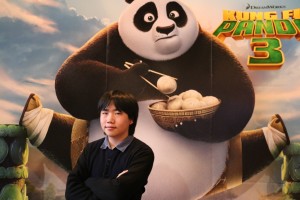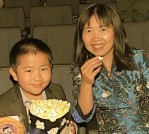Perry’s Previews Movie Review – Kung Fu Panda 3
 Kung Fu Panda 3 begins with a scene of the late Master Oogway (Randall Duk Kim), the wise old tortoise who served as former master of the Jade Palace and singlehandedly created the art of kung fu, now peacefully meditating below a peach tree in the spirit realm. Appearing for the first time since the first Kung Fu Panda film, Oogway’s return is cut short with the introduction of his former comrade, the spirit of General Kai (J.K. Simmons), a fearsome supernatural bovine.
Kung Fu Panda 3 begins with a scene of the late Master Oogway (Randall Duk Kim), the wise old tortoise who served as former master of the Jade Palace and singlehandedly created the art of kung fu, now peacefully meditating below a peach tree in the spirit realm. Appearing for the first time since the first Kung Fu Panda film, Oogway’s return is cut short with the introduction of his former comrade, the spirit of General Kai (J.K. Simmons), a fearsome supernatural bovine.
Wielding two chain-linked God of War-styled jade cleavers which seemingly change in weight and length based on what the film’s plot requires, Kai possesses the ability to drain the chi from his victims, turning them into jade minions under his control. Similar to the widely used fantasy motif we know as “soul stealing”, Kai gains more magical power for every character’s essence he absorbs. Oogway warns Kai that the dragon warrior Po (Jack Black), will stop him, however this only fuels Kai’s inexplicable desire to absorb Po’s chi. Using Oogway’s chi, Kai escapes the spirit world and sets his sights on destroying the Jade Palace, and anyone who stands in his way.
At the same time, protagonist Po is undergoing through a time of many changes. His master Shifu (Dustin Hoffman) retires as kung fu teacher of the palace, and Po is appointed in his stead to teach the martial art. However, as with most things regarding kung fu, he is utterly incompetent. Disheartened, he returns to work at the noodle shop run by his father Mr. Ping (James Hong), only to discover that a panda named Li Shan (Bryan Cranston) has arrived in town searching for his long lost son, who unsurprisingly turns out to be Po. Caught in a tug of war between his biological and adoptive fathers, Po already has more than enough on his plate (aside from the dumplings) when word of Kai’s rampage across the land subsequently leads to the defeat and chi-theft of nearly every kung fu master in China, including Po’s friends: the kung fu masters of the Furious Five. Seizing the opportunity, Li convinces Po that the only way he can win is to come back to the panda village and live with him. Po’s time is running out; for every moment wasted Kai comes one step closer to erasing Oogway’s legacy.
Picking up after the cliffhanging reveal of Po’s real father at the end of the second in the franchise, Kung Fu Panda 3 brings stunningly fluid visual effects to the big screen, and a solid musical score that only improves on the franchise’s prior works.The film’s main plot features Po’s journey in discovering his identity. The filmmakers made a recognizable achievement in incorporating various elements of Chinese culture such as the architecture, and ribbon dancing. Furthermore, the film did feature a great quote by Master Shifu, who advised Po that “If you only do what you can do, you will never be more than you are now.” It’s a shame that a film featuring so many brilliant voice actors, such as Shifu’s Dustin Hoffman would give them so few lines in comparison. For example, with a villain voiced by J.K. Simmons, it’s a shame that General Kai doesn’t even have half the lines given to former villains Lord Shen or Tai Lung. Even among Kai’s existing lines, few actually played to Simmons’s greatest strengths as a versatile actor who can switch from calm to dark, bitter, and wrathful in an instant.
Kai has some big shoes to fill from the franchise that features some of DreamWorks’s best animated villains: Tai Lung and Lord Shen. Each of these three characters are motivated by some sort of revenge. Unlike the other two, Kai’s initial desire for power has absolutely no reason behind it. For one to steal the life essence from individuals who selflessly saved their best friend from the brink of death, anyone would expect a well-planned and significant reason for such an act. Any bit of thought-out background information would enrich the story that much more, because currently it seems that Kai is only a villain for the sake of being a villain. These are characters I lack the most admiration for as a critic. When a villain acts a certain way simply because they are “evil,” they typically become dull and predictable, eliminating two of the most important elements for animated villains: the character’s mystery, and the audience’s ability to empathize and connect with them.
During his face-off with the Dragon Warrior, Kai further displayed poor performance as a villain. For a military general, it’s a pity that tactics and intuition were discarded in favor of creating a brawn over brains “brute force through every obstacle” warmonger whose generally predictable personality. The one defining character trait of Kai is his intimidation, the way he enters every scene cloaked in green mist with eyes eerily glowing, scraping the ground with his swords. Lord Shen of the second movie did not have the luxury of a flashy entrance, but the way he made Po feel and react in despair showed the extent of his demoralizing psychological tactics.
Kung Fu Panda 3 was a pretty enjoyable film overall, definitely better than some sequels and triquels I’ve seen. Evidently, the filmmakers put much effort into making the third installment worthy of its predecessors. However, it appears that with every film, the stories feature kung fu less and less. Based on how chi was represented in this film, it wouldn’t be too far-fetched to see the “kung fu panda” zooming around in a chi-powered car or aircraft, fighting with solely with the magic of chi in the near future. Setting all else aside and focusing on the plot itself, the third installment had its clever moments, but failed to completely match the original movie in terms of originality, and its more serious moments could not compare to the skillfully woven emotional heartbeats, grit, and personal growth of Kung Fu Panda 2.

______________________________________________________________
Perry Chen is the youngest award-winning film/ entertainment critic & animator, artist, speaker, and entertainment personality. He started writing movie reviews at 8 using a kid-friendly starfish rating system, under the guidance of his mom Dr. Zhu Shen and his 3rd grade teacher Ms. Harris. Perry’s debut on the CBS Evening News in 2009 made him a national sensation. He has been featured extensively on local, national, and international media, including NPR, Fox, CNN, NBC, The Guardian, The China Press, and many more. He has interviewed prominent filmmakers at film festivals, red carpet premieres, and press junkets. He won a prestigious “Excellence in Journalism Award” at the San Diego Press Club in 2010 as its youngest member. Perry currently writes movie reviews for the Animation World Network, San Diego Union Tribune, Amazing Kids! Magazine, and his own Perry’s Previews website with a combined readership of over 2 million worldwide. Perry and his family live in the community of Carmel Valley San Diego.
Dr. Zhu Shen’s love for the movies started when she was a young girl, growing up in China during the Cultural Revolution where watching movies was the only entertainment available to the masses. Her journey to become a filmmaker took a convoluted path. She studied medicine at Peking Union Medical College before coming to the US and earning a Ph.D. in biochemistry from University of Colorado, and then an MBA from Cornell University’s Johnson School. She is a producer of the upcoming documentary feature “Average Joe on the Raw,” about journey into raw food and health. Dr. Shen is also an award-winning biotech executive, author, speaker, China business expert featured on national and trade media including CBS, Fox, Business Week, Pharmaceutical Executive, and more. She has worked at IBM, Bayer, Chiron, Immusol, and is the CEO of BioForesight, consulting on cross-Pacific life science business.












You must be logged in to post a comment Login